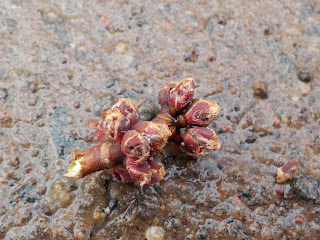Broken branches littered the road from a thrashing wind and rain storm the previous night. I paused occasionally from my walk to pull the bigger ones out of the way so they wouldn’t surprise unsuspecting drivers on the winding gravel road. After dragging a red maple branch—replete with swelling, crimson buds—to the shoulder, I noticed that the soggy gravel was still covered with the brightly-colored clusters.
Had all these buds been knocked off in the storm, too? But why would they remain united in their twig-tip clusters? I picked one up to examine it more closely. Two rings of buds encircled the tiny shoot, and the twig showed a neatly-clipped end. Something had bitten the twig off of the tree. The buds looked intact, though. Why would some creature go to so much effort, and then let it all fall to the ground?
I, too, dropped the cluster as I continued on my walk, but the problem still bugged me. Porcupines often feed on “nip twigs” like this—snipping a branch, then turning it around to access the edible parts—but a porcupine would have nibbled the buds off. Plus, I recently learned that porcupines almost never eat red maples because the plant contains too many acidic tannins as a defense. I’ve seen squirrels feeding on hemlock and spruce buds in this manner, too. But each little spikey green nip twig I recover from that snacking technique is missing its nutrient-packed terminal buds.
When the loop of my walk brought me back to the patch of maple buds on the road, I decided to look more closely. I’m glad I did. Although the buds looked undamaged from afar, when I looked closer, I could see that most of the buds had been gutted. The outer bud scales—bright red with white margins—were still mostly intact, but a single hole in the bud led to a hollow center. Perhaps the muncher was avoiding toxic tannins by only eating the tender embryonic leaves and flowers, and not their tough, protective covering.
A quick internet search revealed that yes; red squirrels, gray squirrels, flying squirrels, and fox squirrels all will eat red maple buds in the spring. No source mentioned that they hollow out the buds, but that’s I observed, and it makes sense as a technique to avoid excess tannins. If that’s true, then I would guess that squirrels have an advantage over porcupines in exploiting this niche—while squirrel teeth might be small enough to scoop the sweet centers out of tiny buds, porcupine teeth most likely are not.
Squirrels must be crafty in this is a hungry time of year, when their supply of fall nuts and seeds has run low, they need energy for breeding season, and extended cold has slowed the arrival of a spring bonanza. Soon (we hope) they will have more food in form of willow and aspen catkins, maple flowers, maple seeds, and even baby birds. Until then, I guess we’re all on the same boat…er, branch…waiting anxiously for spring.
For over 45 years, the Cable Natural History Museum has served to connect you to the Northwoods. Come visit us in Cable, WI! Our new phenology exhibit: “Nature’s Calendar: Signs of the Seasons” will open May 3, 2016.
Find us on the web at www.cablemuseum.org to learn more about our exhibits and programs. Discover us on Facebook, or at our blogspot, http://cablemuseumnaturalconnections.blogspot.com.

No comments:
Post a Comment